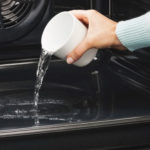For those who are passionate about grilling, a kitchen tool that is essential to satisfy their passion is an oven. However, if the oven is not cleaned after each use, the leftover food will become smelly and breed bacteria, causing unpleasant odor and affecting the quality of the food.

Meanwhile, cleaning the oven is not an easy task, which makes many people hesitate to own one. That is why nowadays manufacturers have added self-cleaning mode to ovens. However, many users still do not fully understand and trust this automatic cleaning feature. Some users have never even pressed the self-cleaning button. Below are detailed information about the self-cleaning mode of ovens that readers can refer to:
1. Self-cleaning function works by heating the oven at high temperature
When you activate the self-cleaning function, it is like small robot arms starting to scrub the oven walls. In fact, when you activate this feature, it heats the oven to a very high temperature. Experts say, “When the oven heats up, it will burn the dirt and debris, turning them into fine powder. Then, you just need to wipe all those away with a wet paper towel, and the stains or unpleasant odor will instantly disappear.”
2. Before pressing the self-cleaning button, you need to remove large food debris stuck inside the oven
The self-cleaning button does not mean it can clean all the stains inside the oven. To thoroughly clean it, you still need to try to remove as much leftover food as possible that is stubbornly stuck inside the oven. Imagine if a cake or any food spills inside the oven, it is likely to trigger the smoke alarm because it will generate a lot of smoke. Repair experts of household appliances suggest that you should also take out the oven racks and clean them separately. Otherwise, they will turn black due to the high temperature when the self-cleaning button is turned on, burning the chrome coating. And you also have to make sure that you remove any remaining baking sheets or silver foil that were left during the previous use.
3. There are some associated risks
In reality, many oven repair calls come from self-cleaning malfunctions. For example, the high temperature when the self-cleaning mode is turned on can make the electronic control panel of the oven too hot and damaged. For this reason, many people even spread rumors that you should never use the self-cleaning function of the oven.
The next concern is the heating elements. Modern ovens almost always have hidden heating elements (which make it easy to wipe away water droplets and spills when they occur), but that means it is difficult for heat to escape from those elements and keep the air circulating. Sometimes the elements get so hot that they can blow a fuse, and those hidden heating elements are often difficult to repair if they break down, requiring users to call professional technicians, which is costly and time-consuming.

4. Use the self-cleaning feature “economically”
Due to the above risks, it is best to use this feature sparingly. The more you use it, the more likely there are chances of malfunctions. Experts advise that you should only use it on holidays or when you need the oven to be completely clean for a party. Besides, you should not use the self-cleaning feature too frequently. Activate it once a week or longer.
According to oven experts, it is best to try this feature for a shorter period of time. Instead of letting it run through the entire cycle, just press the cancel button after an hour. This will minimize risks.
5. Do not use cleaning products to clean the oven
You may think that using additional cleaning products will make the oven cleaner, but it is not advisable when using the self-cleaning mode of the oven. The high temperature is what breaks down all the deposits inside the oven and can be dangerous with chemicals. Experts advise us never to use cleaning products at the same time as the self-cleaning cycle and wait for the oven to cool completely before attempting to wipe it.
6. Precautions should be taken
Even if there are not many burns inside the oven, the hot enamel layer can produce quite strong smoke, so open the windows to ensure proper ventilation. The oven will automatically lock when it gets hot for self-cleaning as a precaution, so do not try to open the oven – doing so may cause an explosion during this process and pose a risk of severe burns.
By V.K – Vietnamnet
“How to Clean a Lock&Lock Oven at Home in 7 Easy Steps”
Don’t let the thought of a dirty Lock&Lock oven get you down. With just a few cleaning supplies, you can have your oven spotless in no time. Have a look at our 7 easy and effective ways to help you rid your oven of all the excess oil and food debris. It won’t take long, so don’t wait any longer – start cleaning now!







































